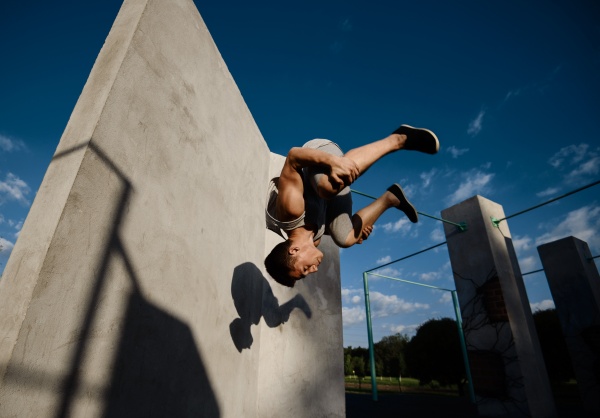Inspect First - Then Refurbish
In recent years, the number of artificial pitches used to practise sports has continued to increase, largely replacing old surfaces such as ...


YOUR FORUM FOR PLAY, SPORTS UND LEISURE AREAS

Although developed over 30 years ago, it is only in recent years that the "sport" of parkour has become a popular leisure pursuit with a large community of fans. This type of movement, which involves participants attempting to navigate a space as efficiently as possible, owes its rise largely to the advent of social media. This is because the acrobatic achievements of which traceurs (as those who pursue parkour are known) are capable look especially captivating in photos and online videos.
The basic aim of parkour is to move from one point to another in an environment without assistive equipment. It is practiced outdoors but in urban settings in particular, where street furniture and buildings are regarded as challenges rather than obstacles. A lamppost is used to help climb a building, from where the traceur leaps onto a wall and then onto the next building and so on. The aim is to progress as smoothly and safely as possible while appearing stylish and acrobatic. Somersaults and back handsprings are just some of the movement elements – there is an abundance of techniques and the practitioner is not just an athlete but also a creative artist. Anyone who observes experienced traceurs will see audacity and aesthetics combined with an entirely different dimension in the use of space.
The description thus far of parkour quickly raises the question of why special facilities are actually required. Traceurs see the challenge in dealing with the prevailing conditions, i.e. in using the space as it is – an environment especially created for practitioners would limit its entire appeal from the outset. While this is undoubtedly true, what must also be borne in mind is that most people are not born traceurs and will probably never master many acrobatic techniques or do so only rudimentarily. The movement form parkour does not simply consist of artistically challenging performances but above all provides the opportunity to push your limits and gauge risk. If someone wishes to jump from one wall to another, this can swiftly result in accidents and injuries in a typical urban environment. And it is children and youths in particular who like to try out moves that look like child's play in videos and risk their wellbeing in doing so.
The first step is always the most difficult and practice makes perfect. Although seemingly trite, these two sayings in fact always hold true. Every traceur also started out inauspiciously. And every traceur needs to constantly work on and improve their technique. This is where parkour facilities come in. For they offer opportunity to practice the basic techniques of parkour and to assess your own skills and risk. And there are also a wide range of approaches and philosophies in design and planning. Ideally, a facility should have several levels of difficulty and offer challenges and appeal to absolute novices and more seasoned practitioners alike.
The biggest target groups for parkour facilities are undoubtedly youths and young adults. For youths in particular it is always difficult to create appropriate public spaces. They have no interest in children's playgrounds and if they do it is often in using them in inappropriate ways that often lead to problems. And it also isn't possible to build a skate park on every corner. The rise of new forms of exercise such as calisthenics and parkour means there are now also facilities that appeal to this target group. Though a parkour facility shouldn't be simply hastily created somewhere. It isn't a playground with a swing and slide, where how it is used is immediately apparent to any outsider. So at the planning stage it is always a good idea to establish contact with a local community or to bring interested sports clubs and education establishments on board. For although using a parkour facility is typically far safer than pursuing the activity in a public space, it is important to have expert advice and guidance. At the very least information signs should be provided which state the rules for use and for avoiding danger. In some places streetworkers are deployed or clubs provide a local exercise offer. This doesn't just enliven the facility but also means lots of novices gain better access to parkour and that the risk of injury can be minimised.
Parkour is also gaining in popularity in schools as it is a fantastic way for children to push their limits and learn to assess risk. While lots of teachers use conventional sports equipment and mats to create temporary facilities in school gyms, a parkour facility nearby could certainly also be used for lessons. This would enable basic techniques to be taught and those pupils with an interest could then hone their skills in their own free time.
For a long time, parkour was ridiculed as a trend and few local authorities were bold enough to establish facilities for fear that they would soon be abandoned if a new trend caught on. However, a few facilities have now successfully been established and the adoption of parkour in schools is also widening its appeal. So parkour is well on the way to shaking off its reputation as a trend sport, even if there is still quite a way to go. After all, skating has been having the same battle for 40 years.
While parkour facilities offer the novice traceur the opportunity to test their skills and learn techniques, more experienced practitioners can use them to train and learn new tricks. However, the real challenges for the latter will always be found outside standardised areas as this is where the spirit of this form of exercise lies.
TT